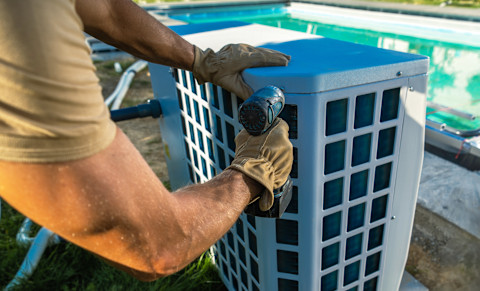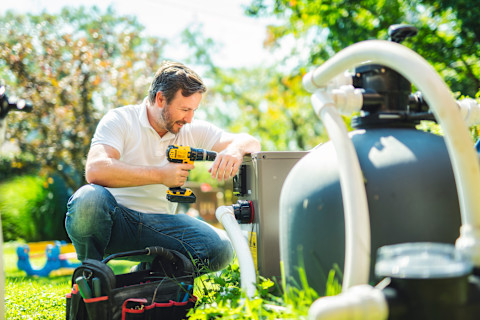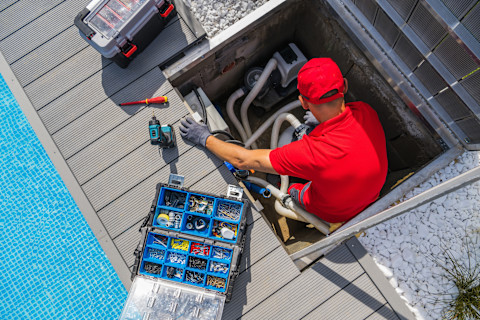DIY Solutions for Building Your Own Pool Heater
Updated on

DIY Pool Heater Solutions: Efficient Homemade and Solar Options Explained
Enjoy a more comfortable swim this season with a DIY pool heater. With a simple homemade solution, you can save on costs while making your pool more inviting. By using solar power, a DIY solar pool heater helps you extend your swim time in an energy-efficient way. Read on for steps to create your own pool heating system and keep your pool enjoyable for longer.
In this article, we will cover the following topics:
- Why Build Your Own DIY Pool Heater?
- Key Concepts of DIY Swimming Pool Heaters
- Essential Materials and Tools
- Step-by-Step Guide to Building a Simple Solar Pool Heater
- Integrating Your DIY Pool Heater with Existing Pool Systems
- Maintenance of a DIY Pool Heater
- Common Questions
Why Build Your Own DIY Pool Heater?
Building your own DIY pool heater offers several notable advantages that can significantly enhance your pool usage experience. Here are some more the main benefits:
- Cost Savings: Significantly reduces financial outlay compared to commercial heaters.
- Customisable: Create a heater tailored to your specific needs and pool dimensions.
- Environmental Impact: Solar-powered heaters contribute to sustainability by using renewable energy.
HomeStars Tip: Before beginning your project, evaluate the size of your pool and local climate conditions to better tailor your DIY solution.
Key Concepts of DIY Swimming Pool Heaters
DIY swimming pool heaters function by transferring heat to the pool water, using sunlight or electricity as primary energy sources. A DIY approach allows for a tailored solution that can suit your specific pool size and environmental conditions. There are several types of pool heaters available for DIY enthusiasts:
-
DIY Solar Pool Heaters: These use solar panels or mats to capture sunlight and convert it to heat, which is then transferred to the pool water. Typically, black tubing is used to circulate the water through the system.
-
Homemade Pool Heaters Using Black Hose: A cost-effective and simple method, this design involves coiling black garden hoses in direct sunlight to naturally heat the water, which can then be integrated with your existing pump system.
-
Home Built Pool Heat Pumps: These devices draw heat from the ambient air and transfer it to the pool water. While more complex than other DIY options, they are efficient and can be combined with solar heating for enhanced performance.
Note: If you’re considering a pool upgrade or a brand-new installation, check out our pool installation cost guide to better understand your investment before moving forward.
Essential Materials and Tools for a Homemade Pool Heater
Creating a pool heater is an engaging project that can help extend the swimming season without breaking the bank. To start, it's important to gather all necessary materials and tools to ensure a smooth building process. Here's a list of essentials you'll need to consider for most types of homemade pool heaters:
- Black PVC Pipes or Hoses: Ideal for absorbing heat, these are fundamental components in designs like solar pool heaters.
- Solar Panels or Solar Mats: Critical for systems utilising renewable solar energy, they help capture and convert sunlight into heat.
- Pool Pump: Ensures effective water circulation through your heating system, which is key for maintaining higher water temperatures.
- Connectors and Fittings: These ensure a secure and leak-proof connection between different sections of the setup.
- UV-Resistant Materials: Extend the lifespan of the system by resisting wear under constant sunlight exposure.
- Basic Tools: Tools such as screwdrivers, wrenches, and pipe cutters are necessary for assembly and installation tasks.
Step-by-Step Guide to Building a Simple DIY Solar Pool Heater

Building your own solar pool heater is a straightforward process that can save significant costs on commercial options. Follow this step-by-step guide to construct a basic solar pool heater:
1. Select the Location: Choose a sunny spot for installation, like a roof or a ground-level area with maximum sun exposure throughout the day.
2. Prepare the Materials: Gather UV-resistant black tubing, a pool pump, hose clamps, and connectors. Clear and level the designated area.
3. Assembly Begins: Arrange the black tubing in a coil on the chosen surface. Ensure it's secured firmly to prevent displacement by wind or water flow.
4. Integration with Pool Pump: Connect one end of the tubing to the pool pump using connectors and hose clamps. Ensure a tight fit to avoid leaks.
5. Water Flow Configuration: Direct the return end of the tubing back to the pool. This allows heated water to flow back into the pool seamlessly.
6. Angle Adjustments: Adjust the angle of the tubing or panels to maximise sunlight absorption during peak hours.
7. Testing the System: Turn on the pool pump. Monitor the water temperature and flow rate to ensure the system works efficiently. Regularly clean the tubing to keep them clear of debris, which can obstruct sunlight and reduce heating efficiency.
8. Final Tweaks: Make necessary adjustments in angles or connections based on initial observations to optimize performance.
9. Safety Considerations: Ensure all fittings are secure and there are no loose parts that could pose a safety risk.
10. Periodic Maintenance: Inspect and maintain all connections, especially before the swimming season starts and after extreme weather conditions.
Note: Choosing high-quality materials is essential to maintain the system's efficiency and longevity, reducing potential repair needs over time.
Save money and energy by hiring a professional tradesperson for your DIY pool heater project instead of doing it yourself. Post your job on HomeStars to find recommended pool companies nearby and compare quotes to get the best deal now!
Get started with pool heating services
Integrating Your DIY Pool Heater with Existing Pool Systems
Integrating a pool heater with your current pool system involves connecting it seamlessly to ensure efficient heating. Start by identifying the pool’s water circulation system. This will determine the ideal connection point for your heater. Often, the heater is connected prior to the pool pump or filter to ensure warmed water circulates effectively throughout the pool.
1. Locate the Pump: Identify the path of the pool’s existing water flow system. Typically, the best spot to integrate your heater is near the pool pump.
2. Install Bypass Valves: These allow you to divert water through the heater or bypass it if needed. This flexibility can be valuable for maintenance or during peak summer months when heating may not be necessary.
3. Connect the Heater: Attach the inlet and outlet hoses from your DIY pool heater to the corresponding points on your existing system. Ensure all connections are watertight to prevent any leaks.
4. Check the Flow Direction: Confirm that the water enters and exits through the correct ports, maintaining the heater’s efficiency.
5. Test the System: Run the pool pump and ensure water is circulating through the heating system effectively. Observe any temperature changes to verify proper functionality.
Note: Always monitor the connections and hoses for leaks or weaknesses, particularly after the initial setup. Make adjustments as needed to ensure maximum efficiency and prolong the lifespan of your DIY pool heater. If at any point you find the plumbing work too complex, you can review typical professional plumbing rates using our plumbing cost guide.
Maintenance and Longevity of a DIY Pool Heater

Keeping your pool heater in optimal condition requires regular maintenance, ensuring it remains effective over time. Establishing a routine for seasonal checks and repairs is vital to extend the heater's lifespan. Below is a checklist to help maintain your homemade heater:
- Regular Inspections: Routinely check all connections and tubing for leaks, blockages, or damage. Pay close attention to any areas subject to wear and tear.
- Clean Surfaces: Remove debris, leaves, or dirt from the heater's surfaces, especially solar panels, to ensure maximum sunlight absorption.
- Monitor Performance: Track your heater's efficiency by observing temperature changes; adjust angles or positions if solar exposure diminishes.
- Winter Preparation: In colder climates, disassemble, drain, and store components when the pool isn't in use to prevent freezing and cracking.
- Ensure Stability: Whether roof or ground-mounted, regular checks for structural stability will prevent shifting or falling in adverse weather conditions.
HomeStars Tip: Implementing a basic maintenance schedule can significantly increase the heater's operational life, making it a long-term investment in your pool's comfort and enjoyment.
Heat Your Pool Efficiently: Find Vetted Pool Experts on HomeStars Today!
Dreaming of a warm pool for those cooler days? Discover reliable, vetted pool company experts on HomeStars who specialise in pool heaters. Post your job now on HomeStars to get started with the right tradesperson for your project!
Upgrade your pool heating system
FAQ: Common Questions Readers Ask About Homemade Solar Pool Heaters
Can a homemade solar pool heater significantly increase water temperature?
Yes, a homemade solar pool heater can considerably increase the water temperature of your pool by utilising the sun's energy. While the effectiveness depends on various factors such as the size of the heater, solar exposure, and the pool's size, these DIY systems can generally raise the water temperature by 2 to 5 degrees Celsius. Maximising sun exposure and ensuring proper circulation of the pool water through the solar collector are key to optimising performance.
How much time and effort is required to build a do-it-yourself pool heater?
Building a pool heater typically requires moderate effort and time investment. Depending on the complexity of the design, it can take between a few hours to a couple of days. You will need to research a suitable design, gather materials such as black PVC pipes, hoses, or old radiators, and construct the system. Basic plumbing skills are beneficial, and patience is required to fit everything correctly and ensure it works efficiently.
What safety considerations should I keep in mind when making a DIY pool heater?
When making a DIY pool heater, several safety considerations are important:
- Ensure secure connections: Loose or improper fittings can lead to leaks that might cause water damage or inefficient operation.
- Use safe materials: Verify that all materials are pool and sun-safe, ideally using UV-resistant piping to prevent degradation.
- Electrical Interactions: Be cautious if incorporating electrical components (e.g., pumps) to avoid electric shock.
- Adhere to local regulations: Consult applicable codes or requirements for DIY construction in your area to ensure compliance.
- Monitor temperatures: Keep an eye on the water temperature to prevent overheating, which could damage the pool liner or harm swimmers.
What are common mistakes to avoid when making a homemade pool heater?
When constructing a homemade solar pool heater, avoid the following mistakes:
- Poor placement: Not positioning the heater in an area with optimal sunlight exposure can significantly reduce efficiency.
- Improper sizing: Failing to scale the system to match pool size and local climatic conditions often results in inadequate heating.
- Neglecting circulation: Ensure proper water flow through the system to achieve consistent heating, using pumps if necessary.
- Overlooking maintenance: Regularly check for blockages, leaks, or wear and tear in the system to maintain performance.
- Ignoring insulation: Insulating pipes can prevent unnecessary heat loss, enhancing the effectiveness of your heater.
By avoiding these pitfalls, you can create an effective and efficient homemade solar pool heater.
Related questions on Ask a pro
See what others are asking our expert pros. Browse all questions
Heating
Extended labour warranty with Trane furnace installation
Ramona Pannewitz 26/11/2025 - 1:41 PM
We had a Trane furnace installed and were told that the 10 year labour warranty was free with the installation. Is this true?
2 answers
Heating
10 year extended warranty for labour
Ramona Pannewitz 25/11/2025 - 9:31 AM
Is it worth it to get this extended warranty on a new furnace installation? Is there a deductible?
2 answers
Heating
Tank vs tankless water heaters
Anonymous user 24/11/2025 - 9:02 AM
What are benefits and cost of replacing a tank vs tankless water heater.?
5 answers
Need expert advice?
Ask a questionDiscuss your job with pros so they can accurately estimate the cost.